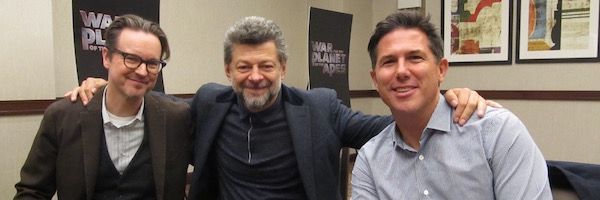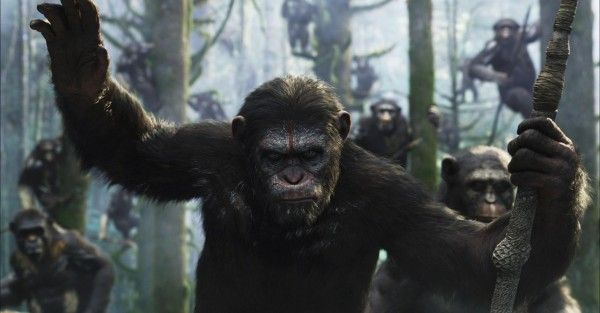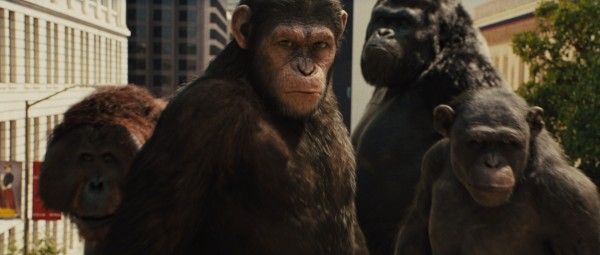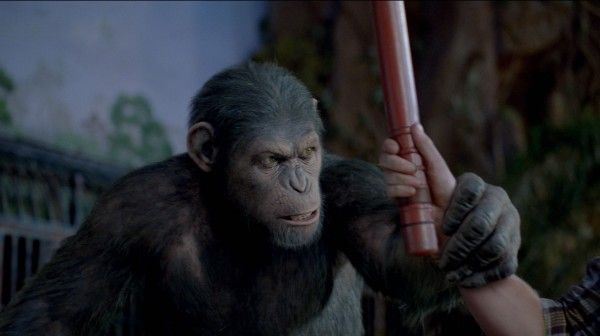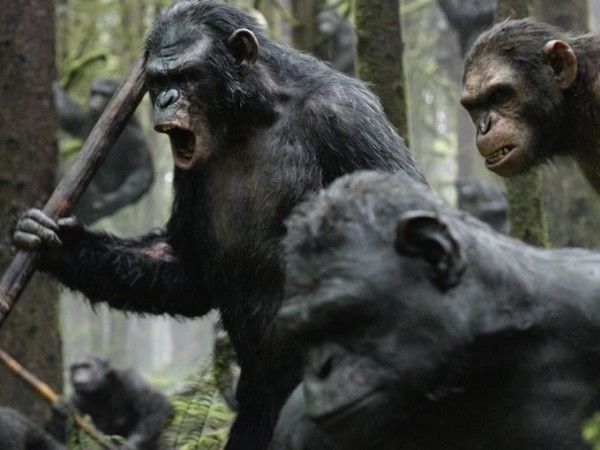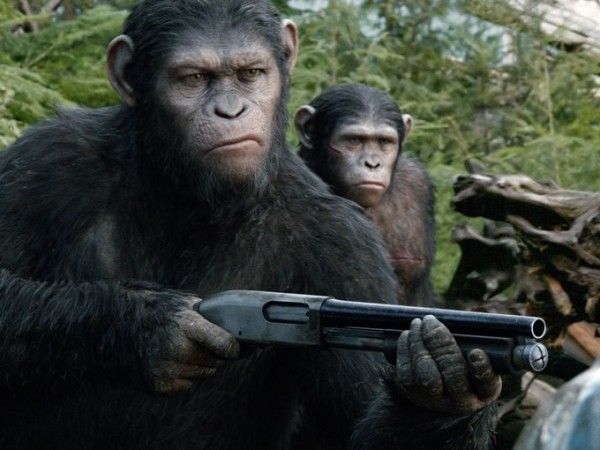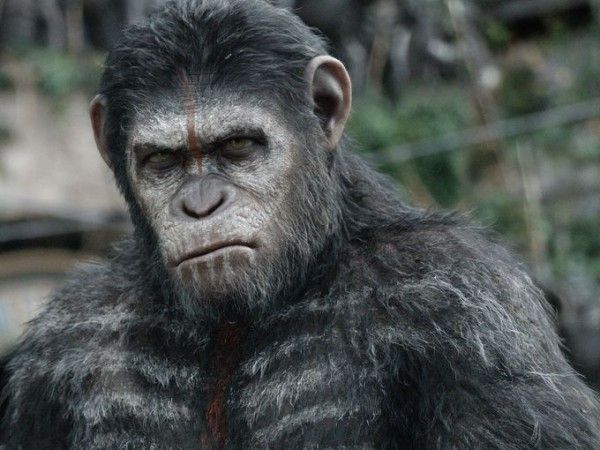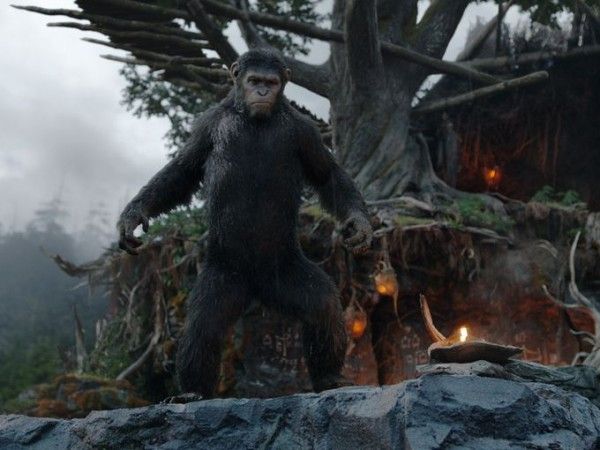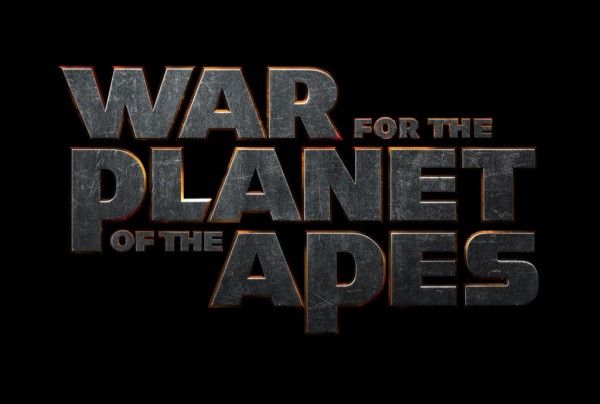2016 isn’t even over yet, and already we’re starting to get excited about the movies coming out in the summer of 2017, partially thanks to 20th Century Fox decision to bring Matt Reeves’ threequel War for the Planet of the Apes to this weekend’s New York Comic-Con.
On the very first day of this year’s con--before Fox had a chance to show any of the footage they planned to premiere later that evening and the next day--Collider had a chance to sit down with director Matt Reeves, producer Dylan Clark and Caesar himself, Andy Serkis, for the following exclusive interview where we were given first-hand information on what to expect. Our interview began with Reeves and Clark, who were almost giddy about finally getting a chance to talk about the movie they’d been slaving over for many months.
Collider: I don’t know if it’s better or worse making the third movie of a franchise where yes, it’s easier to talk about stuff because we know what happened in earlier movies, but maybe there’s more stuff you just don’t want to talk about just yet.
MATT REEVES: We’ve got a lot to talk about.
DYLAN CLARK: We do have a lot to talk about.
Has there been a trailer yet?
REEVES: There’s going to be some surprises tonight and there’ll be a trailer soon.
In the last movie we ended with the humans and apes not getting along, which leads to this movie’s War for the Planet of the Apes. How much time has passed? I know there was a good chunk of time between the first and second movie…
REEVES: This one is two years, so we’re in the battle.
CLARK: We end on Caesar in Dawn in a very specific place. He’s just broken one of his main ape tendencies: “Ape shall not kill ape,” and he’s been told that a force from the North—a real proper army—is coming down to start a war, so when we pick up in War, the war has begun, a war that Caesar did not start.
REEVES: They’ve actually retreated into the Muir Woods, because they know that area like the back of their hand and for lack of a pun, there’s guerilla warfare in the woods. The story starts in the woods, and then it ends up exploding and taking us on a grand journey.
I was curious at what point in the war we come into the movie and what the world looks like now, whether the woods are still there.
REEVES: Oh, yeah, the woods are still there.
CLARK: We talked a lot about this. Matt’s idea was that when we went form Rise to Dawn, a bigger exploration of what the “Ape world” looked like happened, and we got to take the audience into that. From Rise to Dawn, there was kind of an explosion of “Wow, that’s ape architecture.” From Dawn to War, Matt wanted to start in the geography that you understood where the ape habitat was and then lead the audience, through the character of Caesar, on this mythic journey and each stop along the way of these places and the exploration on which the character has to go, are very different. So that we see a more realized, a bigger role than we’ve seen in the previous two movies.
One of the benefits of directing the third movie is that you were able to be involved much earlier and had much more say in what happened. I imagine when you came onto the second movie, there was already some sort of script or idea in place.
REEVES: No, actually when I came onto the second one, there was an outline, and Dylan actually called me, and he said, “This is what we’re doing”…
CLARK: I didn’t actually say “This is what we’re doing”—I said, “Have a look at this…”
REEVES: Okay, so then I looked at it, and then I was like,,. “Oh, maybe I’m not the guy,” and Dylan said, “No, no, no, please. You’re the guy.”
CLARK: Matt and I had a meeting prior that was very important to me… (at this point, Andy Serkis walks into the room and the two filmmakers go absolutely bonkers) No! I was just in the middle of a really smart answer and you interrupted… Nooooo!!! It’s Andy Serkis, ladies and gentlemen. Matt had a real connection to the franchise of Apes, so when I asked him to take a look at where we were, I knew that he had a deep emotional connection to the characters, the mythology of Planet of the Apes, and I knew from our conversation—because he’s an actors’ director—that he would connect with the man who just walked in and ruined my train of thought. That, I knew. That is called producing.
REEVES: (laughs) What I thought in Rise that was so cool was that you thought you were seeing a human based movie, in which there were apes, which was sort of the Heston movie, right? It turns out that it’s a Caesar story, and the most human character in the story is an ape, played by this genius right here. The thing about it is that when I first got involved with Dawn—and there was a clock ticking—the outline they presented me with was not really totally ape-based. Caesar, of course, was in it, but it wasn’t totally his story, and the first thing I said was, “Guys, you earned the right. The amazing thing about Rise is that it’s an ape point of view film, and this one should be even moreso.” To answer your question—16 minutes after you asked it—we changed the story quite a bit.
CLARK: And then when we went to War, and you also said this, having Matt continue with it--with Andy, with the team—there was so much more to explore with the character, so we knew much more of the story we wanted to tell through Caesar and the war in which he’s found himself.
REEVES: I mean, what was exciting to us was the idea that Caesar is the seminal in Ape history, he’s sort of like the “Ape Moses,” and he starts in the first film sort of from humble beginnings, this very rejected sole that as Andy described it—it really moved me—was “He’s an ape and a human and also neither. That he has a foot in both worlds, but an outsider in both.” What I thought was exciting in Dawn was that you take him from this revolutionary who frees the apes from their bondage and then in Dawn, you have this one moment where they could be peace, and he was this unique character in that he had a foot in both those worlds. That’s the story we tried to tell in Dawn, but we also know from the ’68 film that it doesn’t become “Planet of the Humans and Apes,” it becomes “Planet of the Apes,” so that attempt at peace fails, and this film is very much about how Caesar’s challenge to become that mythic figure. The challenge in this story is more dramatic—and they’ve been dramatic in each of them—but this is the most dramatic Caesar story yet.
CLARK: And he’s here, so you may want to ask him a question.
You set it up for Andy perfectly. So Andy, you’re in an interesting place with Caesar, because you’ve played Gollum in a bunch of movies but he never changed much because he’s Gollum. In this movie you get to play Caesar completely different from the last two movies, so what did you want to bring to Caesar this time to have him evolve from the other two movies?
ANDY SERKIS: You know, it’s very rare that an actor gets to play a character from infancy through to maturity and through the whole of his life basically. It really is an incredible journey, and one of the things that was very appealing about this was we’ve always seen Caesar with his moral compass very firmly in place really. He’s had to adjust when he grew up with human beings and had to go live with apes, he had to readjust, and as Matt was saying, he’s always been an outsider, but then he finds his inner ape. He finds himself, and once he has that moral center, it’s very much about home, family, future—all of these structures that he’s putting in place. Things were going well, and then of course, it falls apart, because the side of his life that he’s not actually experienced is hatred from humans.
He’s had love from human beings—that’s very, very important—and he grew up with that. He grew up as a human almost, so that was really crucial to his life experience up until the point of Dawn of the Planet of the Apes where he, in fact, kills Koba basically, drops him, and he carries this guilt with him. In War, we see him still very, very torn up about that, absolutely destroyed by that, and at the same time, war has begun. He’s living now or rather the apes are living under the threat of extinction. Humans are also trying to survive, and it’s a desperate situation where there’s going to be no winners, and they’re basically going to wipe each other out. There is this cataclysmic event early on in the story, which basically takes him on a completely different trajectory, which is a very dark side, which finally enables him to understand where Koba’s anger came from, in a sense.
CLARK: And that’s what’s so beautiful to watch the process of writing with Matt and Mark Bomback, our screenwriter, discover that the story is a war between apes and humans and the fate of each species. The victor gets the planet, but really, the journey, the mythic journey, that Caesar goes through, it’s the war inside the character. Watching Andy grapple with all that… just watching Andy do it from Rise to Dawn and now, these are his biggest challenges has been such a rewarding experience to watch, through the process but also as you see the scenes start to take shape and the movie starts to take the shape, you just realized what grand entertainment this is. It’s a giant canvas. It has big, big entertainment, but inside of it, and that’s what Matt’s genius is, he really gets at the emotional truth to each scene through these characters in a way that’s just profound.
SERKIS: The shoot was just so interesting. It was a very, very hard shoot, physically and emotionally, for all of us. Plus emotionally, there were things going on in our lives that were also informing big cataclysmic things going on in our own personal lives, plus shooting outside, in winter, in very, very harsh conditions, and the third act of the movie or a very large part of the movie takes place in a very inhospitable environment. There was a bleakness to it, but Matt really… I think we both sailed close to insanity. I feel I really sailed close to insanity in this film.
CLARK: I was fine in my trailer. It was interesting to watch these men go down this road, but through that bleakness, what happens is again, the intent and the objective is to find the humanity. The war is about, “Will Caesar regain his humanity and become the Caesar we know and love? Or will he not?” That exploration that Matt went on with Andy was bleak, at times, but the movie… look, I like to think it’s everything.
REEVES: He’s pushed to places… the whole idea was how does what happened with Koba inform this and challenge Caesar and bring him to places he’s never gone to. That’s what happens. That’s what Andy is talking about in the film. The war is this huge external conflict, but almost an even bigger internal conflict, and that process of him going through that brings all kinds of discoveries that also, not only make the movie’s canvas much bigger and grander and more epic, but there actually ends up being more emotion. There ends up being more humor. All of these things, which are surprises in the story, and Caesar is going on that journey, and the discoveries are unlike anything that’s happened in any of the other films, so far. It’s pretty exciting.
Are there any sympathetic or loving humans?
REEVES: Of course!
That’s something that you still had in the second movie is that some of the humans were still trying to get along with the apes.
REEVES: One of the things that has gotten very important to us is the story becomes less interesting the moment that you lose empathy. The thing that blew me away about Rise is that you have empathy for Caesar above all, and the humans you connect to, it only makes your antagonist better if they have valid reasons and your understanding of them has depth. Like Koba… a lot of people say that Koba was the villain of the film or one of the villains of the film. To us, he’s a tragic figure, and in fact, the whole idea is to take these characters and push them into places where you look at what they’re in, and think… For example, Woody Harrelson’s character in this film, he’s in an extreme situation. These are characters in the most extreme situation, and they are pushed to do things in order to secure their own survival, and the things they do are questionable, but the reasons they end up doing them are relatable and understandable, so we don’t try to have any character that you can dismiss as saying, “Oh, that is the bad guy.” So, yes, the humans are meant to have a rich psychological underpinning that brings you into them and that you can come to… I mean, that happens to Woody’s character, as well. You actually feel for him.
I was curious about Woody, because obviously he’s a great actor, but he’s also one of these actors that can be Woody on 5, Woody on 6… he can give you some really fun stuff. I’ve spoken to many directors that have worked with him and he can throw a lot of surprises their way…
REEVES: Sure.
Which Woody did you get on this one?
REEVES: What we got was so exciting. First of all, he loved working with Andy. One of the great surprises, I think, for anyone who is in these films, because there’s all this talk that Andy is the “mo-cap expert” or whatever. That means nothing. What Andy is and what that really means is mo-cap is a technology to record the performance, so what does that mean? It means that this guy is giving a performance that people cannot believe, and when actors are playing opposite him… “So where am I going to stand? Am I going to be looking at the green tennis ball?” No, you’re going to be looking at Andy Serkis, and he’s going to touch you, in your soul, and that’s what happened with him and Woody. They start playing and they go, “Oh, this guy, he’s always on!” and that’s what’s so exciting about the process.
What we got in Woody was somebody who in the beginning was a huge fan of these movies, because he could see there was something going on emotionally. “You know what? I love these movies!” It was one of the first things he said to me, and when he saw what the process was, I think it was even more exciting. What was really cool is that he had thoughts about his character, which we put into the script. He was really engaged, and it was really exciting, and he gave a performance that I think is extraordinary. He’s capable of all kinds of things. He’s capable of being quick-witted, but this is a character who I think is his own creation. It’s something really very rooted in a kind of dark place. He really vibrates with an intensity.
CLARK: I think as a father he came at this place as a man who has raised three daughters, so that when he came into this world of survival, he really put some emotion into it that was higher than 5 and I think it got to 9.
Obviously, you’re almost done with this or in post-production…
REEVES: Oh, the movie doesn’t come out until July, and we are still in that crazy…
CLARK: These movies are never finished.
REEVES: Here is the crazy thing and Andy can tell you this. When you’re shooting, for me, I’m done, so the shooting is crazy. And so when Andy talks about challenging your sanity, it makes total sense, because the shooting is insane. We were shooting out in the rain forest, and this one was shot in the snow, and it was freezing, and they had mo-cap suits on with these wetsuits under then, and Andy is getting thrown into water. It’s like ridiculous. All of that stuff is going on, and the crazy thing is, the harder part is post. I didn’t know that until Dawn. On that, I got pneumonia, and I thought, “Oh, good, now we’re in post, I’ll be fine.” Oh my God! Because the process of putting together material so that you can relate to it emotionally with things that aren’t there. Thank God, we have the actors and we have Andy, because when you’re looking at a cut of the movie, long before there are any apes, what you’re seeing is Andy with his mo-cap camera and the dots on his face, and it’s not Planet of the Apes for a while, it’s “Planet of These Guys in S&M Suits with Dots on Their Faces” and it works! And yet, the challenge of bringing that to life and how that goes on, we will not be done with this movie until right before it comes out.
CLARK: But it’s important to highlight that the process is key. The first part of it is watching the movie put together through the performances of the actors, and in that, we know if we’ve got the scene, that’s our compass.
REEVES: Well, that’s the key to the whole thing.
CLARK: From that, then it’s the process of the technology.
REEVES: The process of turning them into apes and making it look like what you’re seeing and making sure that the apes are, as closely as possible, giving you the emotion that Andy gave or that Karin (Konoval) or Terry (Notary) gives, that is critical. We spend as much time on that. We spend half the day editing and half the time literally on a phone call to WETA in New Zealand, and we’re putting up the take of Andy and we’re also putting up the take of Caesar, and I’m going, “I’m felling more from Andy, why is that?” And then we’re looking at the shapes in Andy’s face and trying to figure out how we can express those on a different anatomy, because Caesar’s face is not Andy’s face. How do you get that feeling of not just rage, but sadness that is coming from some expression Andy gives you, and that’s what we hunt down with WETA for months.
CLARK: At some point, we should, and I think we will, release the DVD of the motion capture actors, the performances…
REEVES: It’s fascinating to watch.
CLARK: So when we do bring people into our process and they just watch a scene with Andy and Karin—Ceaser and Maurice—they fall out of their chair. It’s so powerful.
REEVES: It’s because they don’t realize that it’s all performance-based, it’s all acting, and so everyone’s thinking, “So you’ve got this special trick? You’re really good with CG?” No, what he’s amazing as is that he’s an amazing actor. These are amazing actors, and when you’re watching the movie, they’re not apes for a long time, but the movie still works because the actor give so much.
CLARK: I love it when there are moments when Matt’s looking at shots and he’ll say that he sees Andy in Caesar—he only sees Andy.
REEVES: That’s true. I’m always saying, “Oh, what’s Andy doing here?” and I remember on the last movie, I was saying, “Oh, but in this shot of Andy…” and they were like, “What?” And I’m like, “Oh, Caesar!” because what WETA has to do—and it’s so funny because we have a new cast of apes in this story as well. There are these fundamental designs, but then the process of taking subtle details and making them more like the actors’ faces, so that the expressions can be translated. So we have like this big gorilla this one actor plays, and his face is now more subtly like that actor, so I can see him and go, “Oh, there he is.” It’s funny because I went back and watched Rise after doing Dawn, and to me, it was just like watching Andy. It’s so weird, but that’s really the process.
They’re wrapping us up. I was going to ask you about sequels, but it sounds like you have a lot more work to do on this, so finish it up and we’ll talk about sequels.
CLARK: We know where it ends… Charlton Heston. We have a long way and lots of explorations to go on.
War for the Planet of the Apes will open in North America on July 14, 2017.
War for the Planet of the Apes Images

